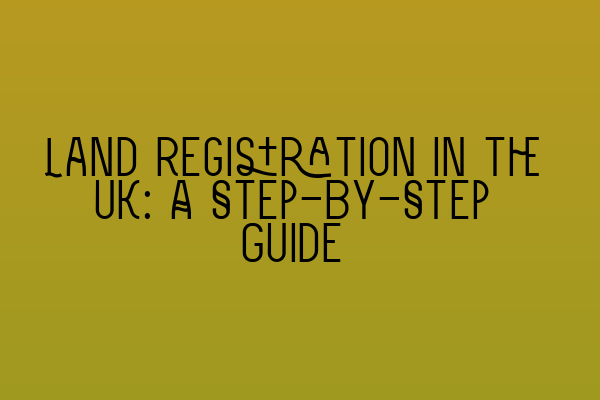Land Registration in the UK: A Step-By-Step Guide
If you’re considering purchasing a property in the UK, it’s important to understand the process of land registration. Land registration is the formal recording of ownership rights and interests in land and is essential for providing certainty and security in property transactions. In this step-by-step guide, we will walk you through the process of land registration in the UK, providing you with the knowledge you need to navigate this important aspect of property law.
Step 1: Obtain Title Information
The first step in the land registration process is to obtain title information from the Land Registry. The Land Registry is a government department responsible for maintaining a register of land ownership in England and Wales. You can search the Land Registry’s database to find out who owns a particular property and obtain relevant title information. This step is crucial as it ensures that you are dealing with the rightful owner of the property.
Step 2: Prepare and Submit an Application
Once you have obtained the necessary title information, you will need to prepare and submit an application for land registration. The application form can be obtained from the Land Registry’s website or by contacting them directly. It is important to carefully complete the application form, providing accurate and detailed information about the property and the parties involved in the transaction. Any errors or omissions may delay the registration process.
Step 3: Pay the Registration Fee
Upon submitting your application for land registration, you will be required to pay a registration fee. The amount of the fee will depend on the value of the property being registered. The Land Registry’s website provides a fee calculator that allows you to determine the exact amount payable. It is important to note that the registration fee is non-refundable, so it is essential to ensure that all necessary information and documentation is provided accurately.
Step 4: Verification of Identity
To prevent fraud and ensure the accuracy of land registration, the Land Registry requires verification of the parties’ identities involved in the transaction. This is usually done through a process called identity verification. You will need to provide proof of your identity, such as a passport or driver’s license, and complete any additional verification steps required by the Land Registry.
Step 5: Document Examination and Registration
Once your application, fee payment, and identity verification have been completed, the Land Registry will examine the submitted documents and check for any discrepancies or issues. This examination may take some time, depending on the complexity of the transaction and the workload of the Land Registry. If there are any issues or missing information, you may be contacted for clarification or to provide additional documentation.
Once the Land Registry is satisfied with the accuracy of the submitted documents, they will proceed with the registration process. Upon successful completion of the registration, the Land Registry will issue a formal registration certificate to confirm the change in ownership and the registered proprietor’s rights and interests in the property.
Step 6: Notifying Mortgage Lenders and Interested Parties
If there is a mortgage lender involved in the transaction, it is important to notify them of the land registration. They will need to update their records to reflect the change in ownership. In addition, it may be necessary to notify other parties with an interest in the property, such as tenants or leaseholders. Failure to notify relevant parties may result in legal complications in the future.
Step 7: Updating Relevant Records and Informing Authorities
Finally, it is important to update any relevant records and authorities with the new land registration information. This includes updating tax records, notifying utility companies, and informing local authorities, among others. By ensuring that all relevant parties are aware of the change in ownership, you can avoid any potential disputes or misunderstandings in the future.
By following these steps and understanding the land registration process in the UK, you can navigate the intricacies of property law and ensure that your ownership rights are properly recorded and protected. If you have any questions or require assistance with land registration or any other property law matters, it is always advisable to seek professional legal advice.
For more information about the SQE exams and preparation courses, please check out our related articles:
– SQE 1 Practice Exam Questions
– SQE 1 Practice Mocks FLK1 FLK2
– SQE 2 Preparation Courses
– SQE 1 Preparation Courses
– SRA SQE Exam Dates
At SQE Property Law & Land Law, we are here to help you navigate the complexities of property transactions and provide expert legal advice for all your property law needs. Contact us today to discuss your requirements and let us guide you through the land registration process with professionalism and expertise.
